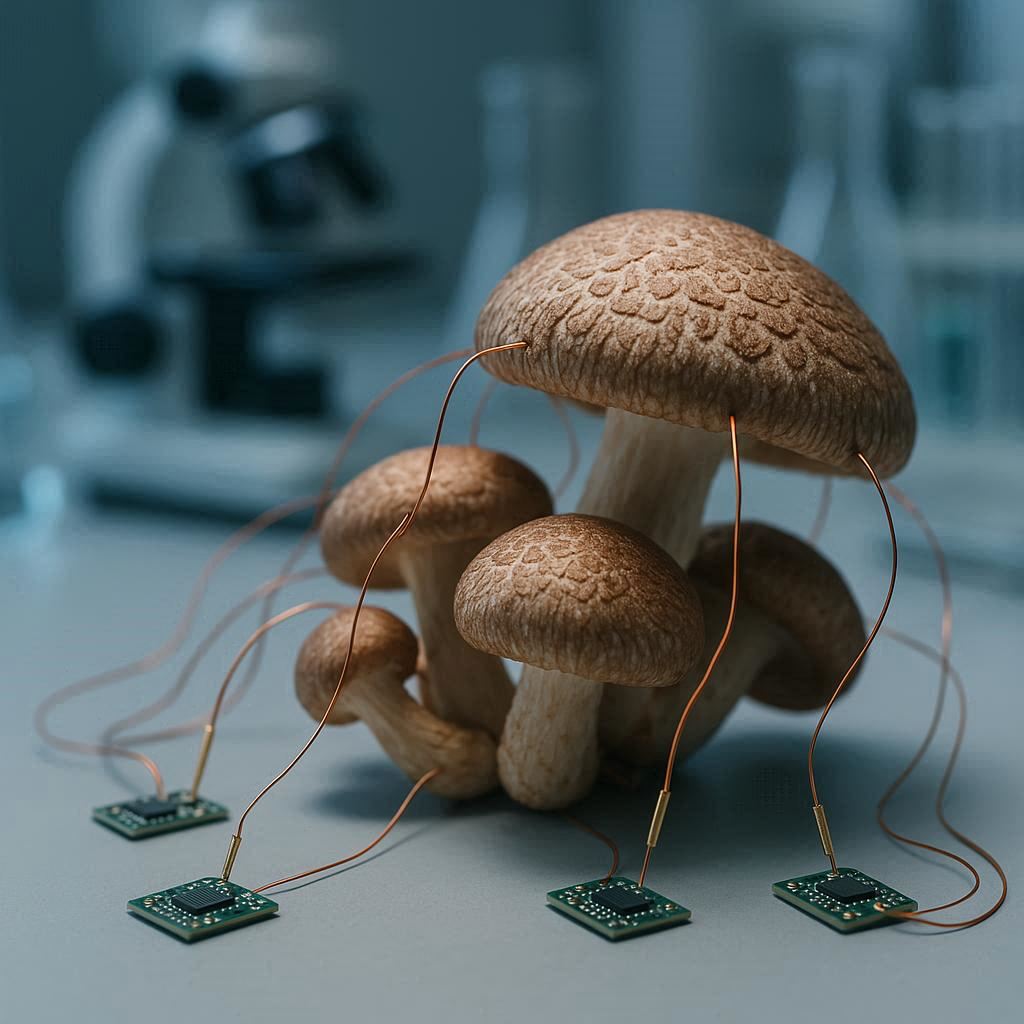For decades, the computing world has been guided by the steady shrinking of metal-based hardware — more transistors packed onto chips, more energy drawn from grids, more heat dumped into the environment, and more electronic waste accumulating in landfills. But what if the future of digital memory and data processing did not depend on silicon wafers mined from rare minerals, but on something living, something soft, something grown? A new study suggests that the answer might be quietly growing in forests and grocery stores: mushrooms.
Fungi have long been recognized for their extraordinary resilience, their ability to thrive in hostile environments, and their elegant biological strategies. In recent years, these strengths have drawn the attention of engineers searching for materials that are not only powerful but also sustainable. The emerging field of bioelectronics asks a daring question: can living tissues perform the kind of information tasks normally done by traditional devices? The new research from The Ohio State University answers that question with surprising confidence. According to the team, common edible mushrooms — including the familiar shiitake — can be engineered to behave like memristors, a key component in brain-inspired computing.
When a Mushroom Acts Like a Memory
To understand the excitement of this discovery, it helps to know what a memristor does. Unlike ordinary resistors, a memristor has a kind of built-in memory: its electrical resistance depends on the history of voltages that have passed through it. This “passive memory” property mimics how neurons in the brain strengthen or weaken connections based on past activity. It is a core building block for neuromorphic computing — systems that aim to function less like traditional machines and more like living brains, which are remarkably efficient.
The Ohio State team cultivated shiitake and button mushrooms, dehydrated them to stabilize structure, wired them with electronic circuits, and then pulsed them with controlled electrical signals. Different regions of the cap and stem responded differently. Over time, the researchers found they could “train” the mushrooms to change electrical states on demand. When used like RAM, the mushroom-based memristors switched states up to 5,850 times per second with roughly 90 percent consistency. That speed is modest compared with industrial chips, yet the proof-of-principle result is groundbreaking for a living substrate that can be grown rather than manufactured.
Bioelectronics as a Response to a Burning Planet
Traditional computing comes with a heavy environmental price: rare metals from destructive mining, carbon-intensive fabrication, massive energy use in data centers, and mountains of e-waste. Fungal memristors, in contrast, are lightweight, biodegradable, low-power, and cheap to produce. According to study co-author John LaRocco, because neuromorphic devices behave more like brains, they consume dramatically less standby power. A fungal chip that “remembers” without drawing constant energy could slash operating costs and reduce the environmental footprint of future computing architectures.
This is not mere ecotech romanticism. If computing continues to scale using its current path, humanity will hit practical and ecological ceilings. Fungal substrates offer a radically different paradigm: electronics that are compatible with biological life cycles rather than opposed to them. They decompose when discarded. They can be grown locally. They eliminate the dependence on rare-earth supply chains. They are proof that sustainable engineering does not require compromising ambition — only reorganizing assumptions.
Teaching Nature to Compute
The researchers did not simply observe mushrooms; they programmed them. With repeated electrical exposure, the fungi exhibited adjustable and repeatable changes in conductivity. When networked together, multiple mushrooms behaved more like a multiprocessor system: deficiencies at higher frequencies could be corrected by adding more biological units, similar to how brains compensate through parallelism.
The devices held their function for months after cultivation. That stability matters for real-world deployment. Co-author Qudsia Tahmina notes that the ease of programming and preserving mushroom substrates points toward future scaling — perhaps from benchtop prototypes to computing fabrics for sensors, wearables, or aerospace systems where biodegradable modules could reduce mass and waste.
Toward a Future Grown, Not Built
Organic memristors are still in early development. The current fungal devices are far larger than would be needed for commercial chips. Future work will tackle miniaturization, new cultivation protocols, and integration into hybrid systems that mix organic and inorganic components. But the obstacles are engineering challenges, not conceptual ones. The principle — that a biological network can perform hardware-level computation — has been demonstrated.
There is also a cultural implication folded inside the science. Whether one stands in a laboratory or a forest, the same truth becomes visible: nature is not only a thing to be exploited but a teacher to be listened to. Mushrooms connect, remember, adapt, and persist without extracting a toll from the planet. In learning to compute with them, researchers are not merely building greener machines; they are learning from a lifeform that already solved problems of resilience and efficiency long before humans arrived.
The Promise in the Humblest Organisms
A compost heap may soon become as meaningful a site of computation as a cleanroom fabrication plant. The Ohio State study shows that knowledge and memory need not be etched into metal — they can be grown from mycelial threads. Fungal computing will not replace silicon overnight, but it opens a parallel path, one in which hardware is cultivated rather than manufactured, dissolved rather than discarded, and aligned with the ecological world instead of exploited against it.
As accelerating demand for computational power collides with ecological limits, mushrooms offer an unexpected lesson: intelligence can be sustainable, electronics can be alive, and the future of computing may be less like designing machines and more like tending ecosystems.
More information: John LaRocco et al, Sustainable memristors from shiitake mycelium for high-frequency bioelectronics, PLOS One (2025). DOI: 10.1371/journal.pone.0328965






